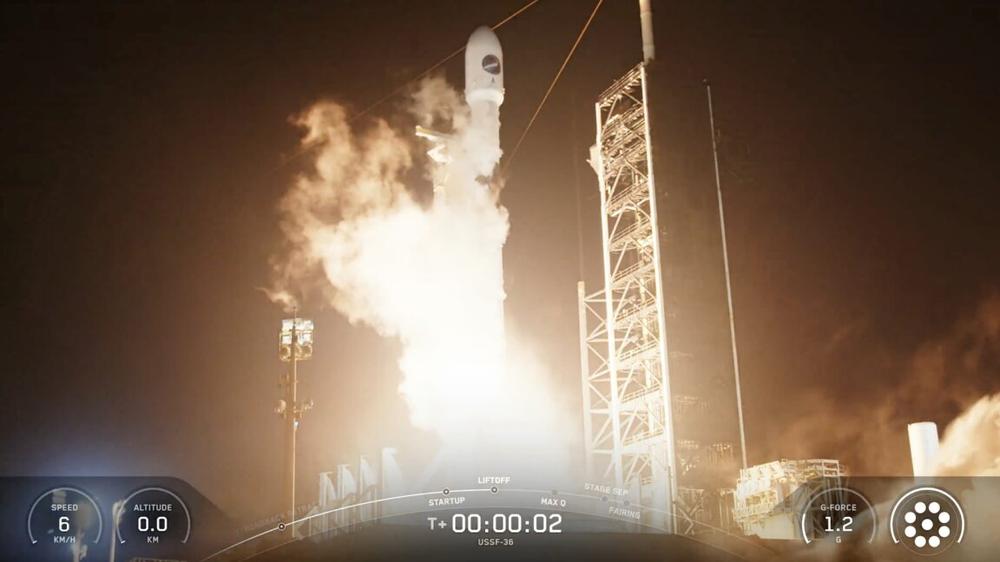The US military's reusable winged spaceship rocketed back into orbit Thursday night atop a SpaceX rocket, kicking off a mission that will, among other things, demonstrate how future spacecraft can navigate without relying on GPS signals.
The core of the navigation experiment is what the Space Force calls the "world's highest performing quantum inertial sensor ever used in space."
This is one of many payloads mounted on the military's X-37B spaceplane when it lifted off aboard a Falcon 9 rocket from Kennedy Space Center in Florida at 11:50 pm EDT Thursday (03:50 UTC Friday).
The Falcon 9 rocket steered downrange and headed northeast from Florida's Space Coast. The rocket's first stage booster detached and returned to an on-target landing at nearby Cape Canaveral Space Force Station, while Falcon's upper stage propelled the X-37B into low-Earth orbit.
Space Force officials declared the launch a success in a press release early Friday. This is the eighth flight of an X-37B spaceplane since the vehicle's debut in April 2010. The X-37B program consists of two Boeing-built spaceplanes, each resembling smaller, unpiloted solar-powered versions of NASA's retired space shuttle orbiters. The program is managed by the Air Force Rapid Capabilities Office in partnership with the Space Force.
Military leaders tout the X-37B's purpose as a technological testbed that can ferry experiments from Earth to space and back. Many of the spaceplane's payloads have been classified, but officials typically identify a handful of unclassified experiments flying on each X-37B mission. Past X-37B missions have also deployed small satellites into orbit before returning to Earth for a runway landing at Kennedy Space Center, Florida, or Vandenberg Space Force Base, California.
On this mission, the Space Force says the X-37B carries instrumentation to demonstrate quantum navigation, and a laser inter-satellite relay terminal to allow the spaceplane to connect with other spacecraft in orbit.
The quantum sensor package will "inform accurate unaided navigation in space by detecting rotation and acceleration of atoms without reliance on satellite networks like traditional GPS," the Space Force said in a statement before the launch.
Preparing for the worst
The Space Force operates the Global Positioning System satellite network to provide navigation services to ships, airplanes, and land vehicles. Originally conceived as a military service, GPS is now vital to everyday civilian life, whether it's in commercial aviation or finding directions to the nearest gas station.
The essential nature of GPS signals make them a juicy target for jamming and spoofing, particularly in geopolitical hotspots such as war zones in the Middle East, Ukraine, and parts of Russia. A wider war between the United States and a powerful adversary, like Russia or China, would likely include attempts to disrupt GPS signals across more regions.
Recognizing the importance of GPS signals, the Space Force said the quantum sensor experiment on the X-37B spaceplane will test technology useful for navigation in "GPS-denied environments." Quantum navigation could also help spacecraft navigate in deep space, around the Moon or other planets, where missions can't count on receiving GPS signals.
The quantum experiment flying on the X-37B is the product of an initiative led by the Defense Innovation Unit (DIU) and the Office of the Undersecretary of Defense for Research and Engineering. Two companies, Vector Atomic and Honeywell Aerospace, worked together to develop and build an atomic gyroscope to undergo qualification for spaceflight.
By measuring the rotation and acceleration of atoms, this new kind of gyroscope can sense motion with improved precision compared to conventional gyros flown on drones, airplanes, and satellites. The quantum payload on the X-37B packages the atomic gyro into an inertial measurement unit, a type of device used on many spacecraft to determine how they have moved through three-dimensional space, what direction they're heading, and how fast they're going.
This experiment is part of the DIU's Transition of Quantum Sensing program, which plans to conduct field tests of quantum sensors in all military domains: land, sea, air, and space.
"Quantum inertial sensors are not only scientifically intriguing, but they also have direct defense applications,” said Lt. Col. Nicholas Estep, an Air Force engineer who manages the DIU's emerging technology portfolio. "If we can field devices that provide a leap in sensitivity and precision for observing platform motion over what is available today, then there's an opportunity for strategic gains across the DoD."
Teaching an old dog new tricks
The Pentagon's twin X-37Bs have logged more than 4,200 days in orbit, equivalent to about 11-and-a-half years. The spaceplanes have flown in secrecy for nearly all of that time.
The most recent flight, Mission 7, ended in March with a runway landing at Vandenberg after a mission of more than 14 months that carried the spaceplane higher than ever before, all the way to an altitude approaching 25,000 miles (40,000 kilometers). The high-altitude elliptical orbit required a boost on a Falcon Heavy rocket.
In the final phase of the mission, ground controllers commanded the X-37B to gently dip into the atmosphere to demonstrate the spacecraft could use "aerobraking" maneuvers to bring its orbit closer to Earth in preparation for reentry.
Now, on Mission 8, the spaceplane heads back to low-Earth orbit hosting quantum navigation and laser communications experiments. Few people, if any, envisioned these kinds of missions flying on the X-37B when it first soared to space 15 years ago. At that time, quantum sensing was confined to the lab, and the first laser communication demonstrations in space were barely underway. SpaceX hadn't revealed its plans for the Falcon Heavy rocket, which the X-37B needed to get to its higher orbit on the last mission.
The laser communications experiments on this flight will involve optical inter-satellite links with "proliferated commercial satellite networks in low-Earth orbit," the Space Force said. This is likely a reference to SpaceX's Starlink or Starshield broadband satellites. Laser links enable faster transmission of data, while offering more security against eavesdropping or intercepts.
Gen. Chance Saltzman, the Space Force's chief of space operations, said in a statement that the laser communications experiment "will mark an important step in the US Space Force's ability to leverage proliferated space networks as part of a diversified and redundant space architectures. In so doing, it will strengthen the resilience, reliability, adaptability and data transport speeds of our satellite communications architecture."

 How to Watch the X-Men Movies in Order
How to Watch the X-Men Movies in Order